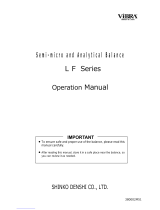
DLB_A-BA-e-1714 3
10 Appliance configuration ................................................................................... 23
10.1 Data output type .......................................................................................................................... 25
10.2 Baud rate ...................................................................................................................................... 26
10.3 Auto Zero ...................................................................................................................................... 27
10.4 Filter .............................................................................................................................................. 29
10.5 Standstill control display ............................................................................................................ 30
10.6 Setting the contrast of the display ............................................................................................ 31
10.7 Display background illumination ............................................................................................... 32
11 Operator menu – mois ture analysis ................................................................ 33
11.1 How to implement drying............................................................................................................ 34
11.1.1 Moisture analysis with drying program PrG1 – PrG5 ................................................................ 35
11.1.2 Moisture analysis with drying program PrG time ...................................................................... 39
11.1.3 Moisture analysis with drying program PrG Auto Mode ............................................................ 42
11.2 Save the drying programs PrG1, PrG2, PrG3, PrG4, PrG5 ...................................................... 46
12 R S 232C interface ............................................................................................. 48
12.1 Technical data .............................................................................................................................. 48
12.2 Pin allocation of the output plug ............................................................................................... 48
12.3 Printout examples (YKB-01N) .................................................................................................... 49
13 General information concerning moisture analys is ...................................... 50
13.1 Application ................................................................................................................................... 50
13.2 Basics ........................................................................................................................................... 50
13.3 Adjustment to existing measuring method .............................................................................. 50
13.4 Preparing a sample ..................................................................................................................... 51
13.5 Sample material ........................................................................................................................... 52
13.6 Sample size / originally weighted in quantity ........................................................................... 52
13.7 Drying temperature ..................................................................................................................... 53
13.8 Recommendations / Guidelines ................................................................................................. 53
14 Error messages ................................................................................................. 54
15 S ervice, maintenance, dis posal ....................................................................... 54
15.1 Cleaning ....................................................................................................................................... 54
15.2 Service, maintenance .................................................................................................................. 55
15.3 Disposal ........................................................................................................................................ 55
16 Instant help ........................................................................................................ 55






















